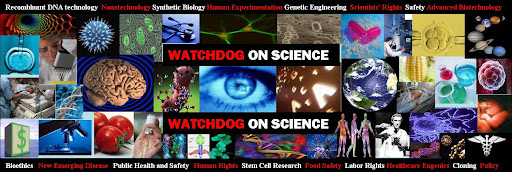 A Report of the Trans-Federal Task Force on Optimizing Biosafety and Biocontainment Oversight was finalized on June 2009. This report outlines the need to optimize biosafety oversight in BL3-BL4 high and maximum containment facilities.
A Report of the Trans-Federal Task Force on Optimizing Biosafety and Biocontainment Oversight was finalized on June 2009. This report outlines the need to optimize biosafety oversight in BL3-BL4 high and maximum containment facilities.Unfortunately the report for oversight does not cover infectious agents used in BL2 laboratories which are more numerous in number, found in every major research institute and which also pose significant worker and public health and safety threats.
Some information in the report is a bit shocking. The government doesn’t even have a current registry of all BL3-BL4 labs where extremely hazardous and contagious biological agents are being used. In addition, the government does not have a centralized incident-reporting analysis for injuries or mishaps in biological laboratories.
Some of the information in the report is also a bit skewed in my opinion. For example, the report includes a table of injury statistics in R&D facilities from OSHA which I find to be unreliable data. The result of this OSHA study gives the impression that R&D facilities have a much lower average of injuries than general private industry. But “not all private R&D facilities were surveyed, and no Federal high or maximum containment research facilities were surveyed”
Also, through my own personal experience, I am more than skeptical regarding OSHA data. When I was employed as a biologist working in R&D in 2002, at least 5 people became ill (incapacitating, headaches, nausea or vomiting) from an exposure from a biological hood and NOT one of the illnesses was reported to OSHA. So much for trusting OSHA data and the dangers at R&D facilities.
Although the report does a good job summarizing the current agencies and regulations which impact biological laboratories, it is a bit slanted in not reporting the weakness of the laws and oversight. For example, the report gives a good summary of the OSHA laws but never mentions that the statute of limitations are so restrictive that the OSHA law is impractical for scientists to report safety problems or illness in biological laboratories.
Similarly they mention that the State of Connecticut instituted a law regarding agents capable of infecting humans. But what they do not mention is that this law does not cover genetically engineered agents or recombinant DN A infectious agents.
The other major weakness in the report is that it does not address our poor whistleblower laws which currently are so weak they provide no protections for scientists and protections for public health and safety. In addition, important human rights issues such as the lack of worker’s right to obtain appropriate exposure records necessary for medical care after incurring a biological exposure was purposely left out of the report.
Despite the fact of its deficiencies, the report is a step in the right direction in an attempt to clarify some objectives needed for better governmental oversight on the most dangerous biological research laboratories in the United States. In short, the report identifies eight new objectives to increase biological safety in these labs. They are listed below:
Summary of Objectives
1. Enhance the overarching framework for biosafety and biocontainment oversight of high and maximum containment research through improved coordination of oversight activities.
2. Encourage a robust culture of accountability characterized by individual and institutional compliance with biosafety and biocontainment regulations, guidelines, standards, and policies.
3. Develop a national strategy to enable and ensure the appropriate training and technical competence of all individuals who work in, oversee, support, or manage high or maximum containment research laboratories.
4. Obtain and analyze information about laboratory incidents to enable trend analysis, minimize the number of future incidents, and share lessons learned, with the overall goals of optimizing laboratory safety and oversight.
5. Ensure that biosafety and biocontainment regulations and guidelines cover current and emerging hazardous biological agents, and develop an agricultural equivalent of the BMBL.
6. Ensure that the infrastructure and equipment necessary for biosafety and biocontainment at high and maximum containment research facilities are in place and properly maintained.
7. Develop and support a national research agenda for applied biosafety and biocontainment to improve the management of biohazard risks.
8. Improve and share strategies to ensure effective public communication, outreach, and transparency about biosafety and biocontainment issues.





